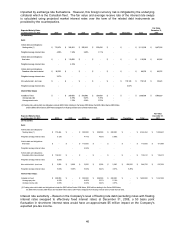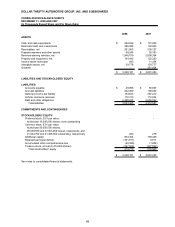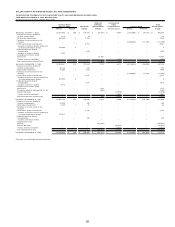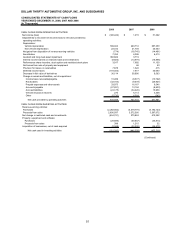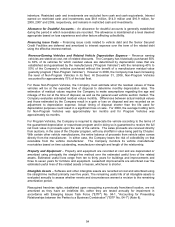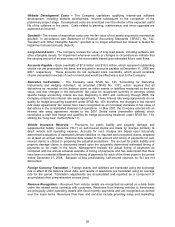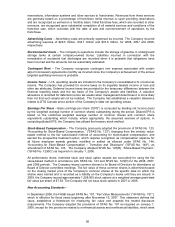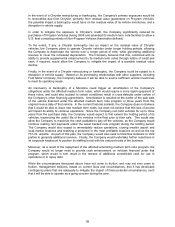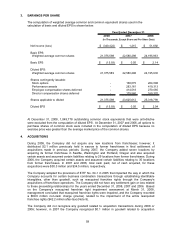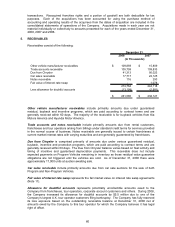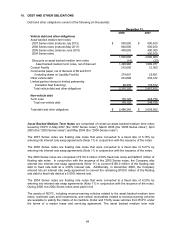Thrifty Car Rental 2008 Annual Report Download - page 56
Download and view the complete annual report
Please find page 56 of the 2008 Thrifty Car Rental annual report below. You can navigate through the pages in the report by either clicking on the pages listed below, or by using the keyword search tool below to find specific information within the annual report.indenture. Restricted cash and investments are excluded from cash and cash equivalents. Interest
earned on restricted cash and investments was $8.9 million, $14.0 million and $16.9 million, for
2008, 2007 and 2006, respectively, and remains in restricted cash and investments.
Allowance for Doubtful Accounts – An allowance for doubtful accounts is generally established
during the period in which receivables are recorded. The allowance is maintained at a level deemed
appropriate based on loss experience and other factors affecting collectibility.
Financing Issue Costs – Financing issue costs related to vehicle debt and the Senior Secured
Credit Facilities are deferred and amortized to interest expense over the term of the related debt
using the effective interest method.
Revenue-Earning Vehicles and Related Vehicle Depreciation Expense – Revenue earning
vehicles are stated at cost, net of related discounts. The Company has historically purchased 50%
to 60% of its vehicles for which residual values are determined by depreciation rates that are
established and guaranteed by the manufacturers (“Program Vehicles”) with the remaining 40% to
50% of the Company’s vehicles purchased without the benefit of a manufacturer residual value
guaranty program (“Non-Program Vehicles”). However in 2008, the Company has been increasing
the level of Non-Program Vehicles in its fleet. At December 31, 2008, Non-Program Vehicles
accounted for approximately 75% of the total fleet.
For these Non-Program Vehicles, the Company must estimate what the residual values of these
vehicles will be at the expected time of disposal to determine monthly depreciation rates. The
estimation of residual values requires the Company to make assumptions regarding the age and
mileage of the car at the time of disposal, as well as the general used vehicle auction market. The
Company evaluates estimated residual values monthly. Differences between actual residual values
and those estimated by the Company result in a gain or loss on disposal and are recorded as an
adjustment to depreciation expense. Actual timing of disposal shorter than the life used for
depreciation purposes could result in a significant loss on sale. For 2008, the average holding term
for Non-Program Vehicles was approximately ten months and for Program Vehicles was
approximately six months.
For Program Vehicles, the Company is required to depreciate the vehicle according to the terms of
the guaranteed depreciation or repurchase program and in doing so is guaranteed to receive the full
net book value in proceeds upon the sale of the vehicle. The sales proceeds are received directly
from auctions, in the case of the Chrysler program, with any shortfall in value being paid by Chrysler.
With certain other vehicle manufacturers, the entire balance of proceeds from vehicle sales comes
directly from the manufacturer. In either case, the Company bears the risk of collectibility on that
receivable from the vehicle manufacturer. The Company monitors its vehicle manufacturer
receivables based on time outstanding, manufacturer strength and length of the relationship.
Property and Equipment – Property and equipment are recorded at cost and are depreciated or
amortized using principally the straight-line method over the estimated useful lives of the related
assets. Estimated useful lives range from ten to thirty years for buildings and improvements and
three to seven years for furniture and equipment. Leasehold improvements are amortized over the
estimated useful lives of the related assets or leases, whichever is shorter.
Intangible Assets – Software and other intangible assets are recorded at cost and amortized using
the straight-line method primarily over five years. The remaining useful life of all intangible assets is
evaluated annually to assess whether events and circumstances warrant a revision to the remaining
amortization period.
Reacquired franchise rights, established upon reacquiring a previously franchised location, are not
amortized as they have an indefinite life, rather they are tested annually for impairment in
accordance with Emerging Issues Task Force ("EITF") No. 04-1, "Accounting for Preexisting
Relationships between the Parties to a Business Combination" ("EITF No. 04-1") (Note 8).
54




